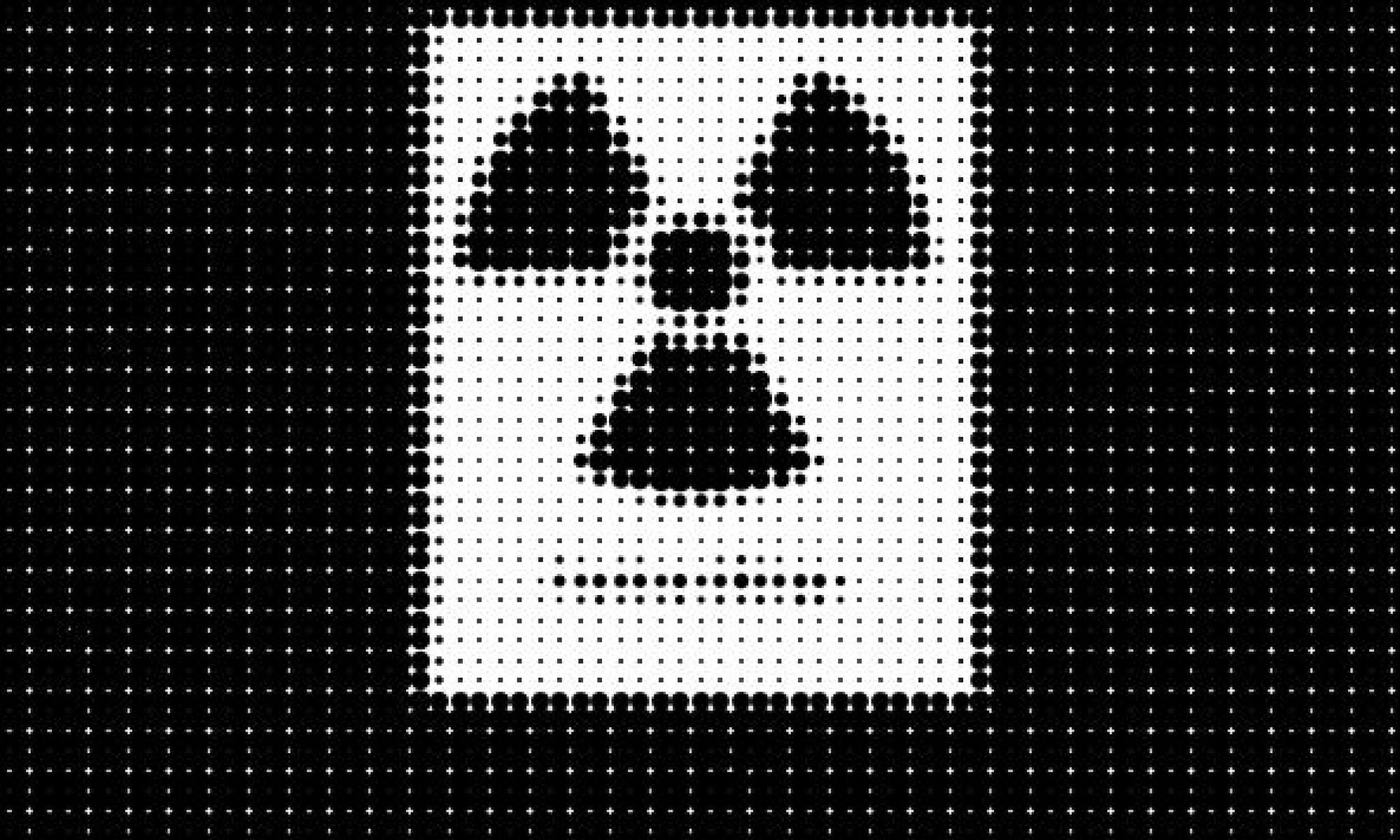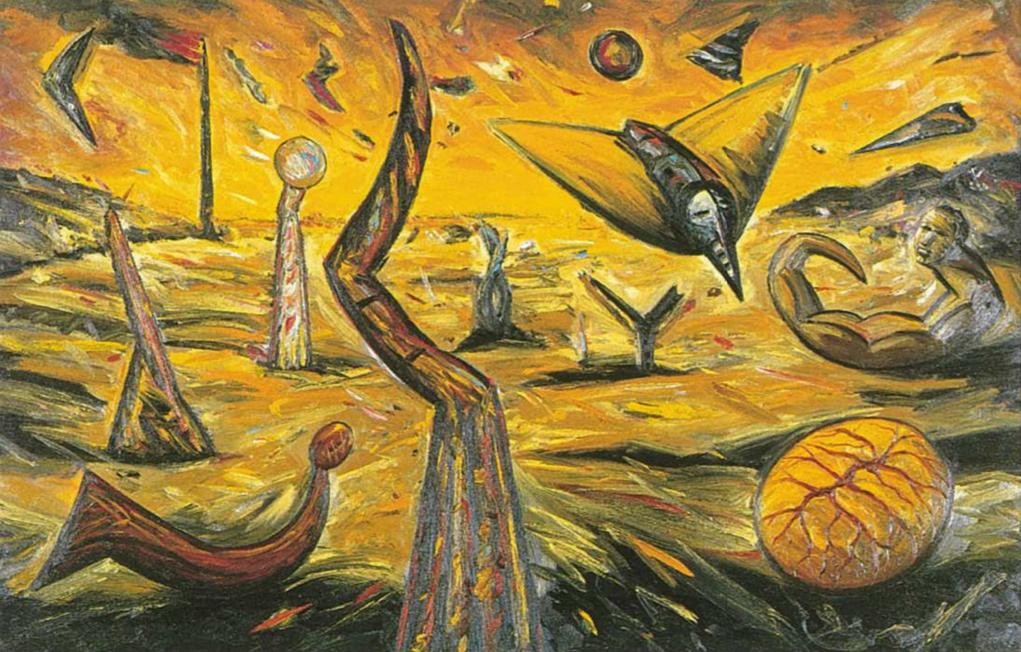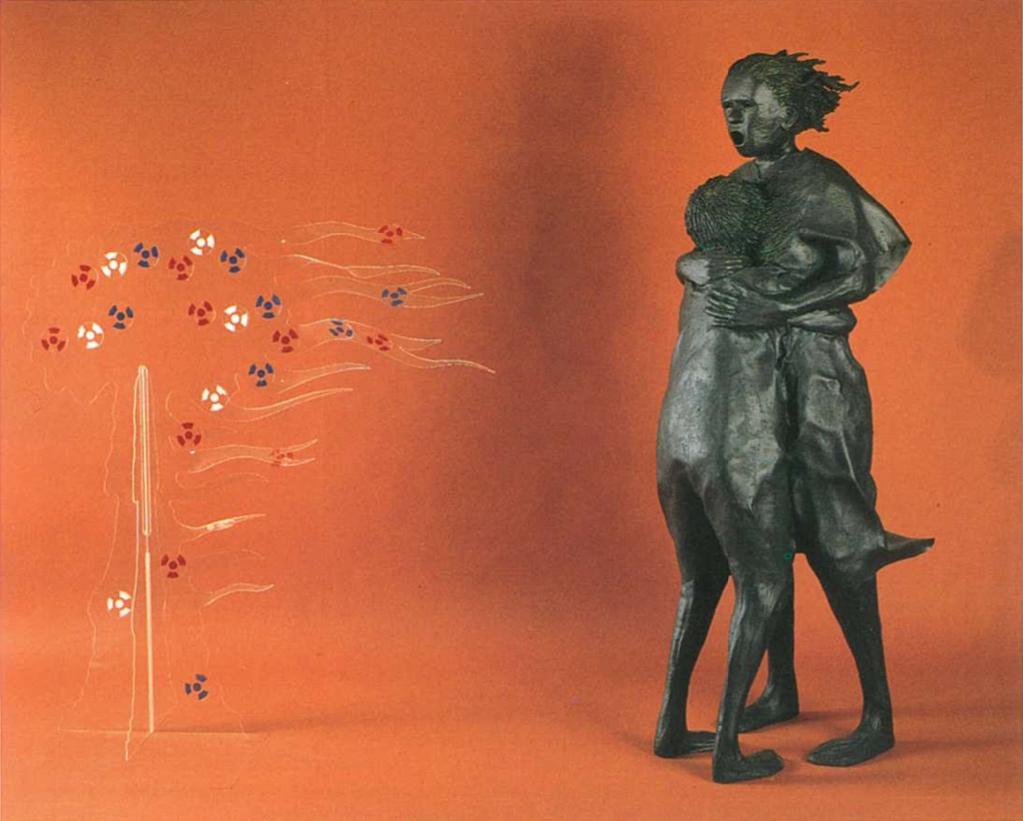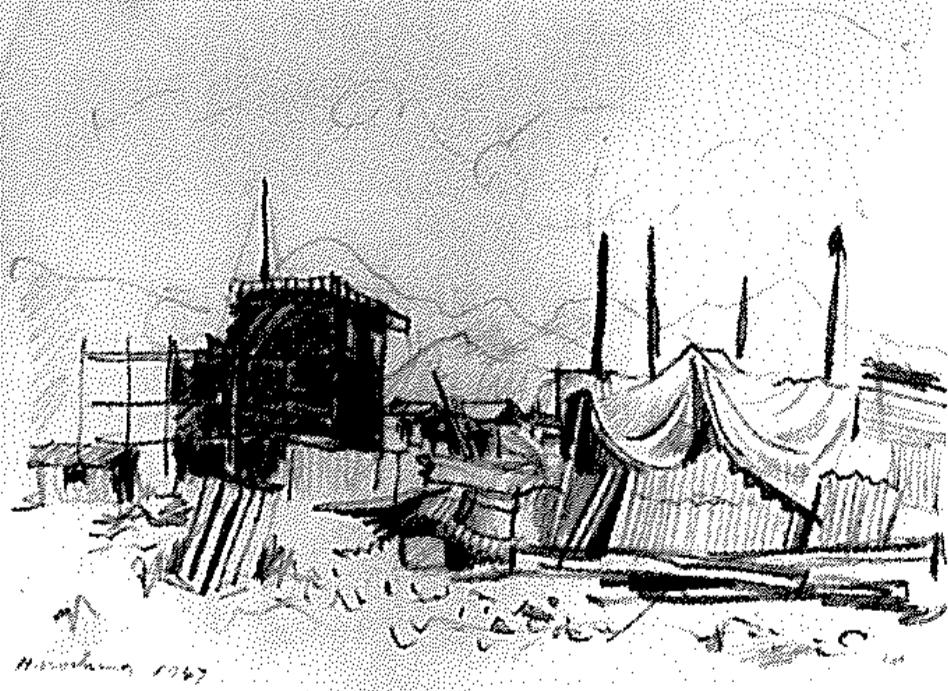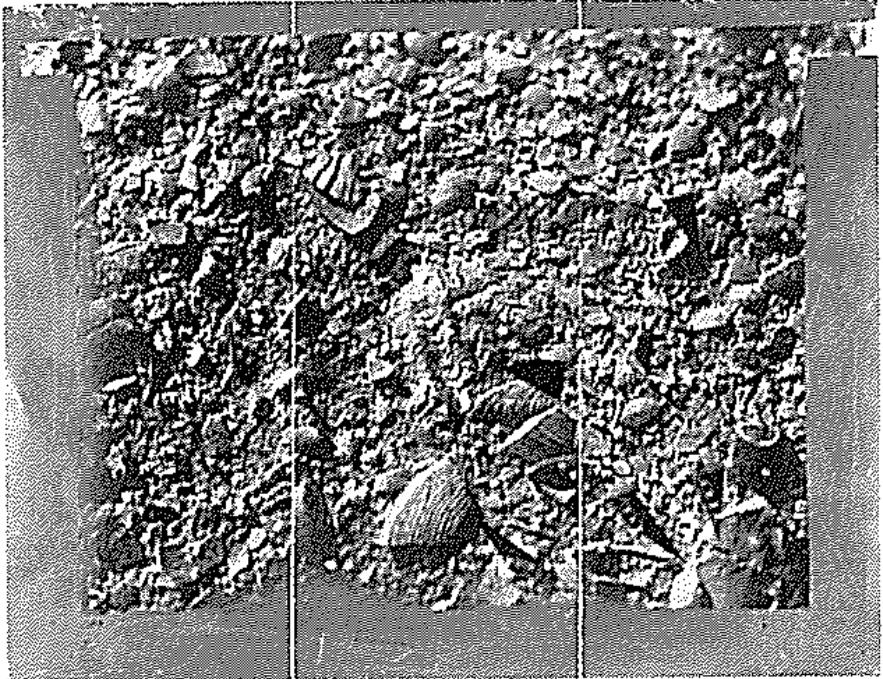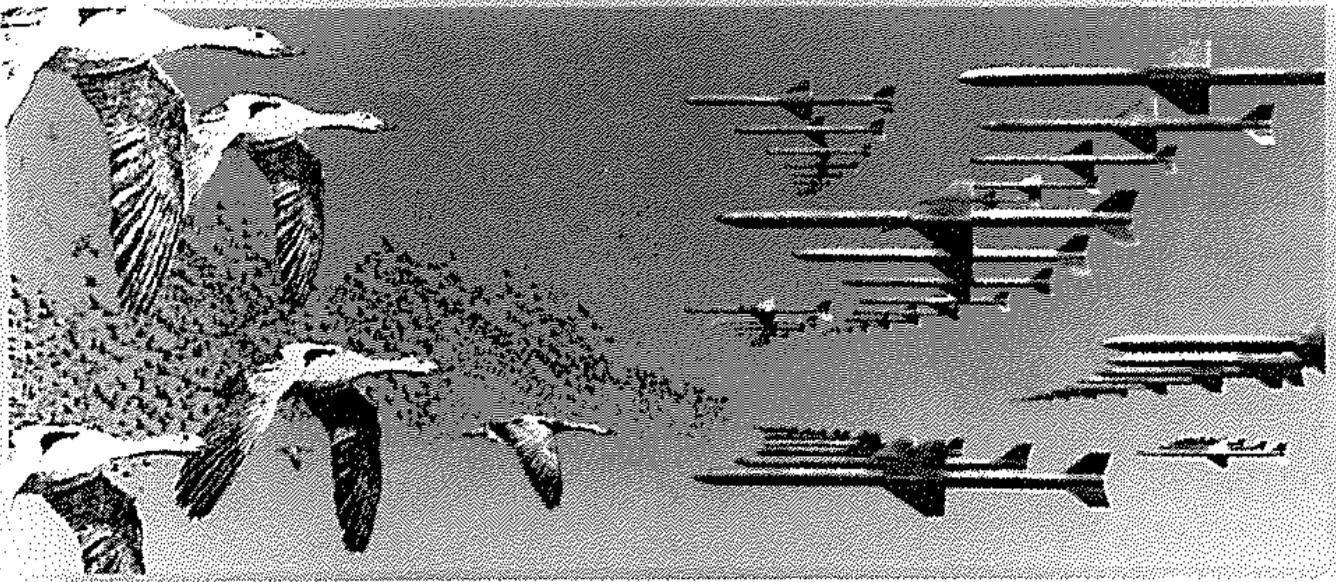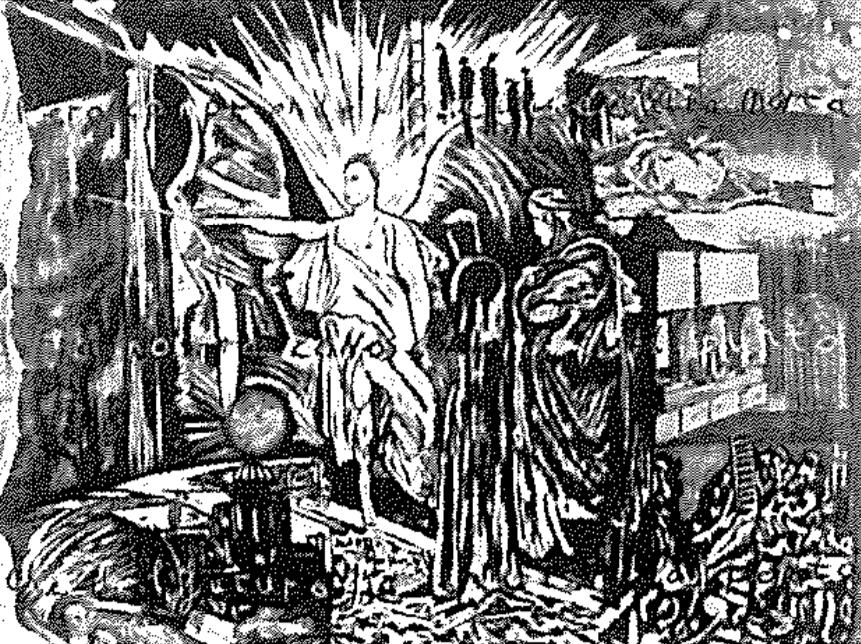Chronology of Events - Nuclear Diary
(republished excerpt from Nuclear (R)age exhibition catalogue. Monash University Gallery, 1993.
Compiled by Rod James
-1945-
16 July: United States of America detonates the first atomic device at Alamogordo, New Mexico.
6 August: USA drops atomic bomb on Hiroshima; a second on Nagasaki three days later brings World War II to an end.
15 November: Proposal by the USA, UK and Canada for a United Nations Atomic Energy campaign to limit the use of atomic energy to peaceful purposes.
James Cant returns briefly to a more expressive style of painting in The Bomb to register his outrage at the 'razing of Hiroshima and Nagasaki'. (1) Alan McCulloch receives news of the atomic bombing while listening to the radio in the Victorian countryside near Alexandria. Initial jubilation at the prospect of the war's end changes to foreboding as he turned to a companion and remarked: 'We'll pay a mighty price for this in a hundred years.' (2) John Perceval was 'profoundly affected' by Hiroshima. 'On the day he learnt of the dropping of the bomb Perceval recalls going into The Rosstown pub (The local for the Murrumbeena pottery) and feeling a profound sense of dismay and isolation as no-one there shared the overwhelming horror he experienced and which obsessed him.' (3) Hermia Boyd's (nee Lloyd-Jones ) Self-portrait at fourteen years 6 August 1945, foregrounds 'youth's moment of questioning expectation as it opens out to experience'. (4) Donald Friend receives news of Hiroshima while serving as a war artist in Indonesia. Although keenly observed, his pen and ink drawing, Officer's celebrating peace Balikpapan August 1945, is a straight depiction of his and fellow officers' attempts to absorb the implications of the event and the recognition that it 'was obviously going to be a new and uncomfortable experience'. (5) According to Clem Christesen writing in the first peace-time issue of Meanjin, 'The atomic bomb, if nothing else [had] severed the old world from the new with guillotine-like decisiveness'. (6)
-1946-
24 January: UN Atomic Energy Commission is established.
5 March: Prime Minister Winston Churchill makes his 'Iron Curtain' speech.
14 June: USA announces Baruch Plan for an international agency to own and control all atomic products. Plan rejected by USSR.
1 July : US Atomic bomb tests held at Bikini Atoll.
Arthur Boyd's biblical allegories, TheMourners and The Mockers exhibited at Rowde n White Library, University of Melbourne. Boyd begins work on the related painting Melbourne Burning. The following year Boyd is joined by John Perceval who begins work on his biblical series including Crossing of the Red Sea and Christmas Eve. According to Barrett Reid: 'In a world of values falling apart they searched for a tradition which could still speak for them. They also searched for permanence in the very materials of their art.' Earlier, Reid had intimated language a s a metonym for a fractured conscious in a response to criticisms levelled by Max Harris at Angry Penguin s writing in the 1940s: ' It was an image of the world breaking down, of poems of this breaking world, of language containing in itself this breaking down. Then it was if we had fathered the atom bomb as the final image of this time.’ (7)
-1947-
12 March: Enunciation of USA Truman Doctrine aimed at checking the further expansion of communism.
Albert Tucker visits Japan in April for a three month period as a war correspondent and illustrator attached to the British Commonwealth Occupation Force. In company with Harry Roskolenko, an American poet and freelance writer previously known to Tucker through joint involvement in the Angry Penguins circle, the two
men travel throughout Japan visiting Kure, Osaka, and Tokyo. Tucker visits Hiroshima on two separate occasions, taking photographs, sketching and painting what he later described as a 'few fairly straight watercolours of some of the shanty towns and ruins in the Hiroshima area'. (8)
-1948-
1 June: Berlin Blockade begins.
Leonard French commissioned for One world fresco at East Brunswick Congregational Church.
-1949-
4 April: Formation of NATO, formalising the European split into competing blocs.
23 September: USSR explodes its first atomic device.
William Hardy Wilson publishes the text Atomic Civilisation and illustrations ·which form the basis of his plan for the city of Kurrajong to be situated in the Blue Mountains West of Sydney. Wilson acknowledges an awakening consciousness of the atom as fundamental to human survival and creativity.
-1950-
North Korean invasion of South Korea.
29 June: Australia officially commits troops to Korean war, indicating its acceptance of the USA's containment policy and perception of Communist China as a threat. Nuclear weapons as a solution to the crisis later mooted by both Prime Minister R. G. Menzies and President Eisenhower (elected 1952).
Weaver Hawkins’ Man is exhibited at Contemporary Arts Society, Sydney. Noel Counihan exhibits the print folio War or Peace in Warsaw. The folio was originally planned to be shown as part of the Second Peace Congress in Sheffield. However, due to British Government obstruction, the Congress shifts to Warsaw at the invitation of the Polish government. Albert Namatjira stakes a copper and uranium claim at Haasts Bluff, SA. People wrote of Namatjira that his painting 'pandered to the selective sense that picked out colour where others saw a uniformity of tinge. He had perfect visual memory and a perfect colour memory’, (9) two prerequisites for the talented prospector.
-1951-
1 September: Signing of ANZUS Mutual-Defence Pact to counter the threat of' communist expansion in the Pacific.
Meanjin publishes Alan McCulloch's article ‘Two Paintings by Roger Kemp' noting the paintings expressed the indomitable spirit of man in a post-atomic world. (10)
-1952-
1 April: Australia, USA and UK sign agreement concerning uranium deposits at Radium Hill, SA.
3 October: UK explodes first of a series of atomic devices on Australian territory which were to continue up until 1963.
1 November: First US hydrogen bomb explosion.
Danila Vassilieff produces Hiroshima during the Korean war and exhibits it two years later in Artists for Peace, Velasquez Gallery, Melbourne. According to Felicity St John Moore, ‘The hybrid male, female and offspring figures refer to genetic mutations caused by nuclear fallout after Hiroshima. The deformed father figure appears again in a carving Animal.’ (11)
-1953-
27 July: Korean Armistice is signed.
12 August: First USSR hydrogen bomb explosion.
8 December: President Eisenhower proposes 'Atoms for Peace' plan to the UN General Assembly.
Sydney Morning Herald reprints New York interview with Salvador Dali in which he declares himself to be a ' nuclear mystic’. (12) Noel Counihan contributes anti-Bomb illustrations to Nat Seeligson's Symphony for Peace.
-1954-
1 March: USA begins thermonuclear tests in Islands, with serious fallout causing alarm.
Blake Prize exhibition includes a painting of the Crucifixion in front of a bomb-blasted city. The impact of the 'turbulent atomic age' is acknowledged in the foreword to the catalogue. 'Melbourne Metropolitan Planning Scheme' for Melbourne includes provision of zones to minimize H-Bomb effect. Decentralisation and the need to address urbanism and civil defence measures in response to nuclear weapons and the greater range of aeroplanes pose a 'formidable' challenge to maintaining 'normal community activities' in a time of war. (13)
-1955-
June: Agreement on the first permanent US installation in Australia, a seismic station at Alice Springs, part of a global network monitoring underground nuclear testing.
Stella Dilger produces a series of poems and paintings commemorating the victims of nuclear war.
-1956-
October: Sino-Soviet agreement on nuclear collaboration.
Australian military campaign to acquire tactical nuclear weapons.
Soviet invasion of Hungary.
-1957-
15 May: Australia and USA agree to exchange information relating to nuclear defence.
'An Appeal from Australian Authors and Artists' asking the Australian Government to work for an immediate cessation of nuclear tests is sent to Prime Minister Menzies. Signatories include William Dargie, Napier Waller, Noel Counihan, John Howley, Leonard French, John Perceval and Charles Blackman.
-1958-
April: Prime Minister Menzies opens Australia's first nuclear reactor, Lucas Heights, NSW.
22 August: USA and UK offer to suspend nuclear tests for one year upon agreement by USSR on a programme of supervision.
Australian tour of Hiroshima Panels by Iri Maruki and Toshiko Akamatsu. Measuring over two hundred feet in length, the eight panels are brought to Australia through the agency of a group of sponsors including Stephen Murray-Smith, Vance Palmer, William Dargie and C.B. Christesen. The works depict in graphic detail the effect of the Bomb on the inhabitants of Hiroshima, primarily through the motif of the naked human body. The exhibition draws unprecedented crowds at each of the state galleries- 'well over a quarter of a million' according to Murray Smith -while in Adelaide people queued in the street to gain admission. (14) The panels draw a largely sympathetic response from art critics. According to Robert Hughes: 'The vision expressed in the panels overreaches national boundaries and goes beyond any particular event; its message runs straight, true and terrible.' (15)
-1959-
1 December: Thirty year Antarctic Treaty is signed by twelve countries (including nuclear powers) banning direct military activities and territorial claims in Antarctica.
An article by David Boyd in the Observer foregrounds the humanist role of art in an age faced with the threat of total annihilation. Boyd's conviction that the artist must, like the individual, reaffirm faith in humanity and imbue his work, with a spirit of optimism is a criterion frequently alluded to in the late 1950s and early1960s, (16) and often in the context of the abstraction/figuration debate. Lawrence Daws' exhibition at Galleria LaSalita, Rome is reviewed by Miraci in L'Unita, in which he parallels Daws' symbols of 'fear and anxiety' with a 'first intuition of' a black cloud that hangs over Europe'. Critics responding to Daws' exhibition at Skinner Gallery, Perth, in 1961, focus on similar ideas. According to Tom Gibbons, the black sun featured in several paintings was an ominous sign of 'purely private desperation, or...a public image of our forthcoming Atomic Apocalypse: or indeed, as both'. (17)
-1960-
13 February: First French atomic explosion over Algeria; shifts facilities to French Polynesia in 1963.
Robert Klippel produces Opus; 91 Hiroshima, while resident in the USA. According to James Gleeson: 'Opus 91 is one of those rare works by Klippel that can be said to have been created in response to a particular experience. He had seen a film about Hiroshima and he gave that name to the tangle of heat-tortured metal that appears to hover like a terrible cloud above an epicentre marked by the vertical rod. It is an extraordinarily suggestive work. One face retains the resemblance of a rectangular grid on which the tormented metal lies in fantastic array, like a wrecked city observed from the air, while the other face coils about like a mushroom cloud discharging its lethal energies into the surrounding space.' (18)
Ralph Balson consolidates his last major series, the Matter Paintings, following contact with contemporary European and American art. Earlier in that year, Balson writes a letter to Daniel Thomas in which he outlines his shift in understanding away from Newton 'with his mechanistic concept of the universe' to an identification with 'Einstein's concept of relativity': '...a universe without beginning, without end. A continuous creating, destroying, and exploding movement, its lone constant the speed of light.' (19)
Other artists to align their interest in early modernist painting with the disintegrative processes evident in natural phenomena include Roger Kemp and Godfrey Miller in his molecular paintings. (20) Working in Paris in late 1957, Sidney Nolan visualises an image 'all whirling around like the inside of an atom'. The resulting painting gained its title The Galaxy following Patrick White's suggestion that it looked more 'like the Milky Way than the inside of an atom: a macrocosm-rather than a microcosm-of the human universe'. (21)
-1961-
June: Australia and USA announce a joint guided missile project at Woomera, SA.
30 August: USSR announces renewal of nuclear tests, followed by USA resumption of underground tests in September.
-1962-
October: Cuban missile crisis erupts during John F. Kennedy's Presidency.
John Perceval's Homage to Lawrence Hargrave is com missioned for the new Lawrence Hargrave Library of Science and Technology, Monash University. The ceramic sculpture mural is an extension of Perceval's Atomic Angel series and a homage to human achievement and, paradoxically, human folly. (22) A smaller version of the central cluster of heads Atomic Cloud (A host of Angels) (1961-62) is exhibited at Zwemmer Gallery, London, 1964.
-1963-
May: Australia and US negotiate Northwest Cape Agreement. 5 August: Limited Test Ban Treaty is signed.
-1964-
16 October: First Chinese atomic explosion.
-1966-
Australia and USA agree to establish an intelligence installation at Pine Gap, operated by USA Defence Dept.
-1967-
27 January: Signing of Outer Space Treaty, banning nuclear weapons beyond the atmosphere.
17 June: First Chinese hydrogen bomb explosion.
-1968-
24 August: First French hydrogen bomb explosion. Nuclear Non-Proliferation Treaty (NPT) between USA and USSR.
Arts Vietnam Exhibition, Gallery A, Sydney. David Boyd's War Game series is triggered by observations of children playing war games in Centennial Park, Sydney and his 'great fear about escalation of war in Vietnam'. The painting The war game is exhibited the following year in his Retrospective Exhibition, Commonwealth Institute Art Gallery, London. Perceval produces a number of watercolours, such as Rainbow and Atomic Cloud, which combine concerns over the Vietnam War with an atomic theme.
-1969-
September: war Australian Atomic Energy Commission recommends Jervis Bay as the ideal site for establishing a nuclear reactor. Prime Minister John Gorton announces the construction of an atomic power plant at Jervis Bay to generate electricity in lead-up to the election proclaiming: 'the time for the nation to enter the atomic age has come'.
-1972-
26 May: USA and USSR sign an Anti-Ballistic Missiles (ABM) systems limitation treaty, and a five year strategic offensive arms limitation agreement and protocol (SALT 1).
28 July: Japan-Australia agreement on the peaceful uses of atomic energy.
-1973-
22 June: USA (under President Richard Nixon) and USSR (under Brezhnev) sign a Pact for the prevention of nuclear war.
Ti Parks' Polynesia 100 exhibited at the 8th Paris Biennale. The work consists of ‘100 photographs of sand on a St Kilda beach, spray painted in pastel colours. The 100 photographs mark the days to a nuclear test in Tahiti, and the coloured sand is polluted in close up'. (23)
-1974-
18 May: First Indian nuclear explosion.
-1975-
July: Ranger Uranium Environmental Inquiry into the mining and export of uranium established in Australia.
-1976-
August: Fifth Conference of non-aligned countries calls for cessation of nuclear weapon tests and the elimination of all such arsenals.
2 November: Newly elected American President. Jimmy Carter promises to slow arms race with USSR and to launch new SALT negotiations and seeks mutual troop and arms reduction in Europe.
Arts Action (Sydney) organises large anti-nuclear exhibition for Sydney Opera House. Around half of the 150 works deal with the nuclear theme. According to Rod Shaw, one of the organisers, 'the idea was a gesture, an affirmation of antagonism to uranium and nuclear economy'. (24) ‘Weaver Hawkins' Atomic Power (1947) and Man (1950) exhibited in Project 11: Weaver Hawkins, Art Gallery of NSW. Ralph Eberlein performs Post Atomic Age at the 2 x 3 Exhibition, Mildura Arts Centre, '...a four-part two-hour ritual in natural bushland adjacent to the art gallery, with an accompanying display of remnants. The artist presented a story of death and rebirth after the age of nuclear holocaust.' (25)
Nuclearism and ecology based concepts in art are explored also in Erica McGilchrist's Nuclear Cactoblastis, exhibited as part of Three Statements on Environment, Ewing and George Paton Gallery. Bea Maddock produces a series of prints dealing with 'the destruction of cities, habitat, environment and people' during her residency at the Australian National University, Canberra. (26)
-1977-
25 August: Prime Minister Malcolm Fraser announces the mining and export of uranium, and stresses safeguards policy.
October: German Chancellor asks USA to deploy new Intermediate Nuclear Forces (INF) to counter Soviet SS20 missiles.
Uranium - The Artists Speak, Arts Council of NSW travelling exhibition shown through 1978 at Maitland and Orange Civic Centre, Participating artists included: David Boyd, Peter Upward, Hermia Boyd, John Coburn, Lloyd Rees, Ted Binder, Peter Powditch, Katie Briscoe and Merilyn Fairskye. Ian Howard exhibition at Watters Gallery, Works Upon our Physical Culture, includes large wax crayon rubbings of US fighter planes made in North America during 1974-76.
A short history of the Tin Sheds, Sydney includes reproductions of anti-nuclear posters by Toni Robertson and Chips Mackinolty, including the latter's ironic play on the sloganising aspect of mass media headlines, Uranium income to finance mutation research. (27)
-1978-
7 April: President Carter announces that production of neutron bomb will be deferred.
June: Australia joins UN Committee in Disarmament.
3 November: Northern Land Council sign The Ranger uranium agreement and uranium mining allowed to proceed on Aboriginal reserves.
Arthur Boyd commences work on Picture on the Wall, Shoalhaven, a large landscape with mushroom cloud rising in the distance. The politicisation of the Australian landscape from afar came about as a reaction '...to Mrs Thatcher who at that time wanted Britain to have the neutron bomb. Its very close stuff, particularly when you are living in the heart of Suffolk. If the hair is blown wrong in Russia, the scalp of England will go off.' (28)
Ken Whisson exhibits Flag for the Bed Brigade and the Hudson Institute (who in their very different wars, have the courage to think, the unthinkable) at Watters Gallery, Sydney. David Humphries' mural for Macquarie University Library focuses on the interrelationships between Aboriginal land rights, environment, media, nuclear power and intellectual training.
-1979-
18June: USSR (Brezhnev) and USA (Carter) sign SALT 11 documents.
16 August: India announces that it might be forced to reconsider its decision on nuclear explosions if Pakistan persists in efforts to make a nuclear bomb.
Three Mile Island Reactor near melt-down, Pennsylvania. Uranium mining leases issued for Ranger and Narbarlek.
December: Soviet invasion of Afghanistan.
Bonita Ely performs Jabiluka Uo2 at PIT Performance Festival, Melbourne. (29) David Kerr commences Radio active Leaves, a performance for an hour each day of the month of May in Rundle Mall Adelaide. (30) Pat and Dick Larter and the Mahouly Utzon Utzon Orgiastic Raga Band's It Can’t Happen Here performance about an atomic reactor incident held at Watters Gallery, Sydney. art Core Meltdown mailart exhibition and event held during September 9 - 15, Old Union Cellar, Sydney University. (31) Here and There, a work by Virginia Coven try consisting of black and white photographs of nuclear power plants with rephotographed newsphotos/text and additional hand-written text, is exhibited in European Dialogue, Biennale of Sydney. Intended as a work in transition, an arrow in the final panel points to the table beneath 'while the story of the near melt-down at Harrisburg which 'completed' the work for its first showing (April/May 1979) remains an intrinsic part’. (32)
-1980-
July: USA inspect RAAF bases in Townsville, Tindal, Darwin and Learmonth as possible staging fields for B52s with nuclear payloads.
21 August: Pakistan announces the manufacture of its own nuclear fuel.
4 November: Ronald Reagan ,wins US Presidency, favours tough line with USSR and rebuilding USA into a great military-political power.
Ken Wadrop's The concept of dread exhibited in Project 31: High Street Studio Realists, Art Gallery of Western Australia. Denis Mizzi's Endgame exhibition Mori Gallery, Sydney. Jane Kent's performance, Yellow Cake, on the steps of Parliament House, Adelaide. Tony Coleing's Yellow Cake installation at Australian pavilion, Venice Biennale. Coleing visits Tahiti for the first time on the way home to Australia, which leads to a number of
works addressing the effects of colonisation on indigenous peoples and the issue of nuclear tests, transport and disposal of nuclear fuel in the Pacific region. The Adelaide Advertiser begins a series of articles investigating the possible effects of British nuclear testing at Maralinga during the 1950s. The newspaper subsequently commissions a number of artists to produce a print for exhibition in the Adelaide Festival Centre. Ann Newmarch's satirical Babies Alive was one such print.
-1981-
6 August: American President Ronald Reagan announces decision to build neutron bomb.
18 November: Reagan proposes 'zero option' on INF. Rejected by USSR's Brezhnev.
Artists Against Uranium organised by Artworkers Union, SA. The exhibition comprising colour Xerox photo copies of original works by Australian artists opens simultaneously at the Experimental Art Foundation in Adelaide and the 'Atom Free Embassy', Lawns of Parlia ment House, Canberra. The exhibition subsequently tours to regional and international centres.33 Toni Robertson produces Royal Nuclear Show series of screenprints while artist-in-residence, EAF. Ann Newmarch's Icon to Posterity included in the 1981 Perspecta, AGNSW. Denis Mizzi invited to participate in the Anti World War 3 Show, Parsons School of Design, New York. We point the bone/Ban the Bomb, a collaborative installation/performance by Tony Coleing and Kevin Mortensen held at Ray Hughes Gallery, Brisbane. First performance of' Prediction Piece One by Lyndal Jones, dealing with the threat of nuclear holocaust. Blood Fountain, a performance by Jane Kent, involving the release of red dye into a fountain as a protest against the neutron bomb. Interpreted by Anne Marsh: 'Blood Fountain was both a vigilante action and a poignant representation of a body, both social and natural, erupting against the determinism of a society bent on destruction.' (34) Headings of Peter Booth's apocalyptic landscapes imaging the world at/over the edge of catastrophe become commonplace. (35)
-1982-
27 May: The government under Premier John Cain announces Victoria to be a nuclear-free State and nu clear powered vessels to be prevented entry into ports.
First Artists for Peace exhibition is organised by the Association of International Co-operation and Disarmament, Sydney. Ivan Durrant includes the sculptures, Uranium and Meltdown in United Artists exhibition. Work on Michiel Dolk and Merilyn Fairskye's Not Nuclear and Ruth Waller's Space Invaders renewable billboards for Woolloomooloo community mural project. World Dream, by .Jane Kent part of Adelaide Festival of Arts. Theo Tremblay performs Silent Demonstration in Canberra, a piece previously used in parades and rallies in Boston and Oxford in the 1970s. (36) British film director, Peter Watkins, visits Australia to galvanise support for a new film about the nuclear arms race.
-1983-
23 March: Reagan unveils Strategic Defence Initiative programme in nationally televised address, claiming that it would render nuclear weapons 'impotent and obsolete'.
Campaign by international scientific community to publicise 'nuclear winter'.
Britain suspends its longstanding practice of dumping
nuclear waste at sea after strong international opposition.
May: The enactment of the Maralinga Tjatjura Bill
restores to Aborigines land the government had resumed in 1953 for testing atomic weapons.
November: First USA INF (Cruise) missiles arrive in Germany; Soviets walk out of INF talks.
Mike Brown notes in artist's statement accompanying the What Now? installation at Heide Park and Art Gallery his shift towards a socially engaged art: 'I shall endeavour to create an anonymous concatenation of colour, form, texture and line, to titillate your eyeballs and satisfy your souls. Meanwhile, kindly spare a thought that at any moment now, all life on this planet may summarily cease, which to say the least, would make my efforts in preparing this exhibition a little pointless.' John Howley is commissioned to paint six anti-nuclear murals of exploding food for Leo's Spaghetti Bar, Fitzroy Street, St Kilda.
-1984-
14 November: NSW Nuclear Disarmament Party launches election campaign - formed 6 months earlier in protest to ALP 'softness on uranium mining and proliferation of nuclear weapons'.
Publication of the McClelland Royal Commission into Nuclear Tests.
Denis Mizzi curates Soft Attack,: Artists Against Militarism, Artspace, Sydney, exhibiting Dogs of War. Participating artists include Ruth Waller, Ian Howard, Victor Rubin, Pam Debenham and Geoff, Weary with La Sera. Forces of Resilience installation of Marcus Champ's Star Wars, Ian Were's Helmets for World War IV and Mark Thompson's Victims, Survivors and Monument Marquettes, Jam Factory, Adelaide Festival Program. Opening of Artists for Nuclear Disarmament, Hiroshima Commemoration Art Exhibition, Sydney Lower Town Hall. People for Nuclear Disarmament's Artists. For Peace Exhibition is held at Rod Shaw's Studio, Sussex Street, Sydney. Patrons include Lloyd Rees, David Boyd, John Coburn and Barry Jones. PostAtomic Card, a national and international exhibition of mail art is held in Melbourne, Universal Theatre and Monash University. Exhibition of John Howley's Aftermath series of post nuclear war paintings including The giant blood pump and Punk Survivors, Acland Street Gallery, Melbourne. Ian Howard is invited to submit work in Urban Targets, Nuclear Show, Open Space Gallery, Vancouver (touring Canada and USA). Lyn Ashby's Peripheral Vision triptych of pre to post-nuclear holocaust Sydney wins Lady Fairfax Award for Photography, Art Gallery of New South Wales. Victor Rubin exhibits The Perfect Mutant, Realities, Melbourne. Ivan Durrant exhibition of meat pieces Uranium - You're Standing in It, Melbourne. Peter Cole's The Last Undefeated Maneater is exhibited in A Jaundiced View, Ray Hughes, Brisbane. Peter Robertson is commissioned to produce poster for ‘Joint Seminar of the Medical Association for the Prevention or War and Scientists against Nuclear Arms', South Australia, and in the following year, with John Edward, posters concerning health and welfare issues and nuclear war.
-1985-
March: Mikhail Gorbachev becomes new Soviet leader.
10 .July: Sinking of the Rainbow Warrior by French secret agents prior to the Greenpeace vessel's departure for atomic test ground at Mururoa atoll.
Ruth Waller commences work on large charcoal drawings (Untitled) and a series Eighty Six: Scenes after Hokusai/the Bomb following a visit to Japan. Sources for the work include John Hersey's contemporary account, Hiroshima, drawings by survivors, documentary footage or US tests in Nevada during the 1950s and depictions of the holocaust in a Justice League or America Comic. The series is later reproduced in booklet form with additional works dealing with disappearances in Latin America. Ivan Durrant exhibition of Short Memories series, including Enola Gay and Hiroshima, United Artists, Melbourne. Installation of Theo Tremblay's Gestures and Facades: A two-sided target, Canberra School of Art. Later exhibited in the Print Council of Australia's Print as Object touring show. Peace and Nuclear War in the Australian landscape, an installation by Jan Birmingham, Tanya Crothers and Darani Lewers opens Adelaide Festival Centre Gallery; subsequent tour to Gryphon Gallery, Melbourne and Ivan Dougherty Gallery, Sydney. Quegli Ultimi Momenti, a multi-media installation addressing anti-fascist/anti nuclear struggle and the experience of Italian migrants in Australia presented in Perspecta '85,Australian Cen tre for Photography, Sydney. 'Visual Arts and Nuclear Disarmament Conference' held at the City Art Institute in October. Speakers include Charles Merewether, Julie Ewington, Bruce Petty and Lloyd Rees.
-1986-
10 April: USA under ground nuclear test at Nevada: on following day Soviet Union announces the end of a unilateral moratorium on tests.
26 April: Chernobyl nuclear power station disaster.
Ivan Durrant exhibits works detailing the effects of radiation mutation on Chernobyl victims in Ivan Durrant-Year of Peace, United Artists, Melbourne. Toni Robertson exhibition Sites of Power: an exhibition of posters and prints, University of Queensland Art Gallery. Redletter Press backstreet visions retrospective 1980-86 held at Gryphon Gallery, Melbourne, featuring a selection of anti-nuclear posters by Mark Denton, Fiona Somerville, Bob Clutterbuck, Chris Reidy and others.
-1987-
Further development of Soviet 'Glasnost' policy.
December: USSR and USA sign INF Treaty, which marks the 'beginning of the end' or the 'Cold War' between the two powers.
Eden Finale shown in Ivor Francis Retrospective, Art Gallery of South Australia. Charles Anderson's The Last Door exhibiled at Roar Studios, Melbourne. Stella Dilger:
Works on Paper 1940s-1970s exhibition at Verity Street Gallery, Melbourne. Victoria Cattoni's Challenger paintings exhibited in Fabrications, recent contemporary art in Tasmania, Chameleon Gallery, Hobart. Ann Wulff installation of signs location/Relocation in St. Johns Square, Perth as part or ARX 87. According to Ted Snell, 'She cleverly punctuated the isolationist mentality of many Australians (now linked to a version or Neville Shute's On the Beach syndrome) with her witty signs pointing to the proximity of Three Mile Island, Chernobyl and the economic flow on effects of international finance…’ (37)
-1988-
Charles Anderson's triptych Today, here, now, The debris of...-endo-colonisation is exhibited at Christine Abrahams Gallery, Melbourne. Though exploring the effects of nuclear war and the 'destruction of the environment through the flurry of colours and distorted images', the work is indebted to Paul Virilio's notion in Pure War concerning societal non-development resulting from the maintenance or a permanent war economy. (38)
Publication of Mick Broderick's Nuclear Movies: A Filmography.
-1989-
23 October: Spanish Nuclear Safety Council discloses an accident in the Vandellos 1 nuclear reactor in north east Spain as the worst in the country's nuclear history.
November: Two million East Germans flood through breaches in Berlin wall, which had divided the city since 1961.
Denis Mizzi's exhibition Ground Zero, Tin Sheds Gallery, Sydney. Visiting British sculptor Jason Hartcup exhibits work combining detritus, sand from the West Australian desert and scale models of military hardware, 'overlaying images of destructive technologies of contemporary warfare' on the environment. (39) According to Ted Snell, Hartcup's desire to incise a giant nuclear-powered submarine on the desert salt lakes was not realised. John Hughes and Peter Jordan receive Australian Film Commission support to develop a film script for August 6th, a work exploring the questions of 'nuclearism', myth and history.
-1990-
Disintegration or the Warsaw Pact. Iraqi invasion of Kuwait.
Signing of Conventional Armed Forces in Europe (CFE) Treaty.
Ian Howard retrospective exhibition, Decor, at Charles Nodrum Gallery, Melbourne includes Monumental Sub- marine and Interior Architecture. Work from the preceding eighteen months addressing demilitarisation in Europe is exhibited in Out of the Cities of Hope, Watters Gallery, Sydney.
-1991-
The Gulf war. lraqi violations of the NFT are uncovered. Strategic Arms Reduction Treaty (START I) is signed by American President George Bush and Soviet President Gorbachev. Disintegration of the USSR.
4 September: New Russian President, Boris Yeltsin, calls for international moratorium on underground weapons tests and pledges to pursue 'total elimination of nuclear weapons in Russia'.
November: NATO reduces nuclear arsenal in Europe. December: NATO and former Warsaw Pact countries (including Russia) establish close links.
Merilyn Fairskye exhibits Green-Blue (J. Robert Oppenheimer, Washington, 1950) at William Mora Gal leries, Melbourne. Art and Australia special issue, 'Art and War', includes articles on Pam Debenham, Ian Howard, and contemporary visions of war. Eclipse of the Man-Made Sun, a film by Amanda Stewart and Nicolette Freeman, awarded ANZAAS/CSIRO Best Science Film, 1991 Melbourne International Film Festival.
-1992-
January: Cancellation of W88 warhead by the Bush Administration.
February: Pakistan's Foreign Secretary, Shahryar Khan, confirms his country's nuclear capacity.
9 April UN team begins destruction of lraqi nuclear installations. Clean-up teams in Iraqi and Kuwait ac knowledge the environmental and human impact of Depleted Uranium (DU) armour-piercing shells used by American Forces in the Gulf War.
11 Nov Australian Government's consent to the sale of uranium to Indonesia for a nuclear power program.
Analogies of the Nuclear Age series by Ross Duncan exhibited at Roar Studios, Melbourne. Jonathan Kamantjara-Brown produces Maralinga Story. Peter Burgess exhibits a series Object of/From the Familia Irene Sutton Gallery, Melbourne. Tony Coleing's M.A.D. paintings, including /watch Out ...Out...Out... at Charles Nodrum Gallery, Melbourne.
-1993-
2 January: Nuclear reactor incident at Kursk, 600km SW of Moscow classified as level O incident on 7-point International Nuclear Event Scale. There were 140 incidents reported in Russian nuclear plants in 1992, most of which were registered at less than 0.
Signing of START II Agreement
5 February: Report of Soviet Union use of Arctic Ocean as a dumping ground for nuclear wastes for over thirty years.
12 March: North Korea announces intention to withdraw from Nuclear Non-Proliferation Treaty.
14 May: US Secretary of Defence signals end of SDI project.
24 May: Australian Government urges Britain to make reparation for the clean-up of the Maralinga atomic test site. By June Britain has agreed to assist this process.
Garry James's installation Winners featuring collage, flags, radioactive rocks from Hiroshima, fairy wands, canvas map of Northern Territory exhibited in Tourist, William Mora Galleries.
Nuclear R(age), a survey of the Bomb and nuclear economy in Australian art, exhibition at Monash Uni versity Gallery, Melbourne.
Additional information by Dr Andrew Butfoy, Lecturer, Politics Department, Monash University.
Selected References
Harry and Jill Redner, Anatomy of the world: The impact of the atom on Australia and the world, Fontana/Collins, 1983. (Main source for chronology of events 1945-1982).
Alice Cawte, Atomic Australia 1944-1990, NSW University Press, 1992.
Australia's Events and Places, Fairfax, Syme and Weldon, Sydney, 1987.
Keesings Record of Events, 1982-1991.
John Newhouse, The nuclear age: From Hiroshima to Star Wars, Michael Joseph, London, 1989.
Notes
1. Ron Radford, James Cant 1911-82 Retrospective, Art Gallery of South Australia, 1984, p.6.
2. Alan McCulloch, interview with the author, August 1986.
3. Barrett Reid, Of Dark and Light: The Art of John Perceval,
National Gallery of Victoria, 1992, p.21.
4. Patricia Dobrez and Peter Herbst, Art of the Boyds: Generations of artistic achievement, Bay Books, Sydney, nd, pp.126-27.
5. Gavin and Colleen Fry, Donald Friend: Australia War
Artist, Currey/O'Neill, Melbourne, 1982, p.54.
6. C.B. Christesen, editorial, Meanjin, Vol.4, No 4, 1945, p.175.
7. Barrie Reid, 'New Time, New Place', Ern Mally's Journal,Vol.1, No.-1, 1952, p.47; Reid, Of Dark and Light, p.21.
8. Quoted in James Mollison and Nicholas Bonham, Albert Tucker, Macmillan, Melbourne, 1982, p.42. Brief details of Tucker's visit to Japan are contained in Christopher Uhl, Albert Tucker, Lansdowne, Melbourne, 1969, p.46,
p.89. For a thematic discussion of the images and their linkages with articles by Roskolenko see R. James, 'Decor for a Doomsday Frolic', Journal of the Australian War Memorial, 22, 1993, pp. 18-22.
9. Cited in Noel Sanders, 'The Hot Rock in the Cold War', in Ann Curthoys and John Merritt (eds), Better Red than Dead. Australia's First Cold War, Vol.2, Allen and Unwin, Sydney, 1986, p.159.
10. ![]() Meanjin, Vol.10, No.1, 1951, p.48. The two paintings reproduced in Meanjin were exhibited in 1947 at Kosminsky's Gallery, Melbourne as Church Buildings and Younger Generation. Church Buildings was later exhibited in Roger Kemp: Cycles and Directions 1935-75, Monash University, 1978.
Meanjin, Vol.10, No.1, 1951, p.48. The two paintings reproduced in Meanjin were exhibited in 1947 at Kosminsky's Gallery, Melbourne as Church Buildings and Younger Generation. Church Buildings was later exhibited in Roger Kemp: Cycles and Directions 1935-75, Monash University, 1978.
11. Felicity St John Moore, Vassilieff: A retrospective exhibition of painting, sculpture and watercolour, Heide Park and Art Gallery, 1985, p.27.
12. 'Man of a thousand fears paints the atom', Sydney Morn ing Herald, 4 January 1953, p.4.
13. 'Melbourne Metropolitan Planning Scheme', Melbourne Metropolitan Board of Works, 1954, p.28. See also, Rosina M. Edwards, 'Planning for the atomic age', Twentieth Century:An Australian Independent Quarterly,Vol.6, No.3, 1952, pp.50-54.
14. Overland, No.13, 1958, p.19; No.9, 1958, p.18.
15. Robert Hughes, Observer, 26 July 1958, p.372. See also Alan McCulloch, The Herald, 2 April 1958, p.2; Arnold Shore, The Age 1 April 1958, p.2. Artists also regarded the exhibition as a tour de force. 'Mirka Mora saw them in the company of Joy Hester and recalls that both of them were overwhelmed.' Interview with Gary Catalano, 1977, quoted in Catalano, The Years of Hope. Australian Art and Criticism 1959-68, Melbourne: Oxford University Press, 1981, p.17.
16. David Boyd, 'An end to art critics', Observer, 10Jan. 1959,
p.13. See also 'Resolution of the Artists and Writers Conference', Australia New Zealand Congress for Inter national Co-operation and Disarmament, Melbourne, 7- 14 Nov. 1959, CICD archives; C.B. Christesen, 'Letter circulated to Australian artists and Writers', 3 June 1958, Meanjin Peace Movement Files, University of Melbourne;
John Hetherington, 'John Perceval: His Angels affirm his
faith in man', The Age, 24 March 1962, p.18.
17. The Critic, Vol.1, No.9, July 1961.
18. James Gleeson, Robert Klippel, Bay Books, Sydney, 1982, pp.222-23.
19. Quoted in Bruce Adams, 'Metaphors or scientific idealism: The theoretical background to the paintings of Ralph Balson', in Anthony Bradley and Terry Smith (eds),Australian Art and Architecture: Essays presented to Bernard Smith, Oxford University Press, Melbourne, 1980, pp.188- 9.
20. See, for example, Bernard Smith's reference to Miller's 1952 canvas Unity in Blue in Australian Painting 1788- 1970, (1962) Oxford University Press, Melbourne, 1978, p.303.
21. Cited in .Jane Clark, Nolan: Landscapes and legends,
National Gallery of Victoria, 1987, p.128.
22. On details or the commission see Jenepher Duncan, 'Monash and Art: The collection, commissions and gallery', in F.W. Kent and D.D. Cuthbert (eels), Making Monash: A twenty-five year history, Monash University, 1986, pp.83-4,. On the Atomic Angels see Margaret Plant, John Perceval, Landsdowne, Melbourne, 1971, pp.131-9.
23. Jennifer Phipps, Off the Wall/In the Air: A seventies selection, Monash University Gallery, 1991, p.56.
24. Rod Shaw, interview with Merilyn Fairskye, Art Network, Nov. 1979, p.24.
25. Anne Marsh, Body and Self: An analysis of performance art in Australia 1969-1989, unpub. M.A. thesis, Monash University, 1991, p.138.
26. Correspondence with the artist, 1992. For Maddock these and the complementary work Blue Orange I IV represent 'the Armageddon that we are faced with in the twentieth century'.
27. Chipsmackinolty, 'The TinSheds' in Charles Merewether and Ann Stephen (eds), The Great Divide, Landsdowne, Melbourne, 1977, pp.131-9.
28. Quoted in Sandra McGrath, The Artist and the River: Arthur Boyd and the Shoalhaven, Bay Books, Sydney, p.188.
29. See Charles Green, 'Living in the Seventies', Off the Wall/ In the Air, Monash University Gallery, p.9.
30. 'l gradually printed/published a poem on the leaves of the lower limbs of the Plain trees in the mall. As the Winter set in the leaves dropped as leaflets in the street...The poems were translated into French and the work was performed in Lyon and Paris as part of the CAIRN- collec tives' God keep these things from our· shores event in 1980.' Correspondence with the artist, Sept. 1991.
31. art Core Meltdown was organised by Pat Larter in con junction with Cees Francke, Terry Reid and Madalaine Spiller. The 'entire edition of the Union Recorder became the mailart Show catalogue' (Dick Larter, letter to the author, 24.8.92). A series of performances, readings and other events were organised in conjunction with the show.
32. Virginia Coventry (ed.), The Critical Distance:Work with Photography /Polilics/Writing, Hale and Iremonger, Sydney, 1986, p.14.
33. The proposal for the exhibition came from David Kerr. A working party was formed at the SA branch of the Artworkers Union and the exhibition was co-curated with Christine Goodwin.
34. Anne .Marsh, op.cit., p.152
35. For example, Janine Burke, 'Art for the end of the world', Meanjin, Vol.40, No.3, 1981, pp.375-88; Robert Rooney, ‘Peter Booth anticipates the holocaust', The Age, 10 Dec. 1981, p. 10.
36. 'A demonstration between the War Memorial and Parliament House where I handed out chalk to Marchers and instructed others to lay down and be outlined to show what a mass death scene would look like. The silhouettes continued for three kilometres from Anzac Parade, across King's Bridge and Commonwealth Bridge to the Old Parliament House Building'. Correspondence from the artist, 1993.
37. Art and Australia, Vol.28, No.4, Autumn 1988, p.330.
38. Paul Virilio and Sylvere Lottringer, Pure War, trans. Mark Polizzotti, Semiotext (e) foreign agent series, New York, 1983, p.54; Louise Bellamy interview with Charles Anderson, The Age, 11 Oct. 1988.
39. Ted Snell, 'Jason Hartcup', Tension, No.23, 1993, p.60-61.

